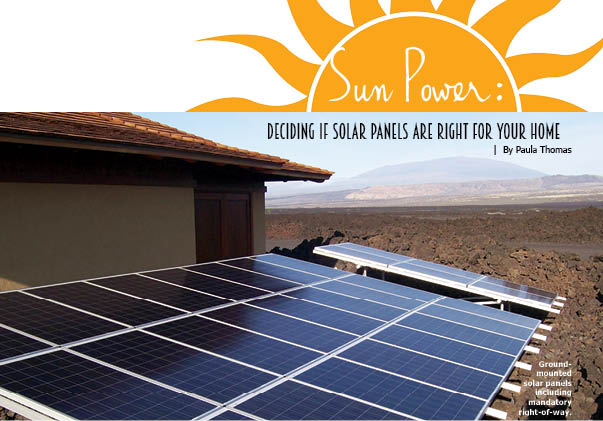
Sun Power: Deciding if Solar Panels are Right for Your Home

By Paula Thomas
For people in Hawai‘i, where the cost of energy per kilowatt hour (kwh) is about the highest in the nation, the biggest incentive for going solar is to reduce the long-term cost of energy.
The good news is that the current net metering system in the state of Hawai‘i can result in a household paying just $20.50 per month. However, that’s after you invest thousands in a photovoltaic (PV) system that is set to generate your power based on the average amount of electricity you use monthly over the course of a year. The bad news is that net metering system is going to be restructured, according to electric utility officials, because it is not sustainable.
What Does It Take?
To shift from purchasing electricity from a utility company to generating your own solar power requires relatively high upfront costs. There is no way around that. Solar panels are relatively expensive and getting them installed, wired, and properly metered are added costs. These costs will vary significantly depending on how you go about installing what you need and how much power you want to generate.
The first factor is your overall energy usage.
A quick glance at your electric bill will show you your monthly usage. Add all those numbers up and divide by 12 and you have your average monthly energy usage. That number will determine how many panels you may require. If you are planning to expand your family or add an addition to your home, then your average monthly energy draw will likely increase, and that needs to be factored in. Similarly, if you plan to purchase additional high energy-drawing appliances like dryers, freezers, or refrigerators, you may need to factor that in as well.
The second factor is the quality of the panels you purchase. The higher the quality of the panel, the more expensive each panel will be. Solar companies on the island are pretty good at explaining the types of panels they offer and the reason for cost differences.
Another factor that plays into cost is the condition of your roof. You cannot install solar panels on a rusted or deteriorating roof. You will notice, if you pay attention to those buildings that have solar panels, that the roofing underneath the solar panels is either brand new or has been treated, which may not be true for the rest of the roof. Since most panels have a 25-year guarantee, the roof underneath them has to last that long, as well.
Some homeowners opt for a ground-mount. This is just as viable and comes with a slightly different set of parameters and installation requirements. Wherever your solar panels are set up, the way they are mounted is just as important as the type of panels you buy. It is worth your time to research the most secure and effective way to mount your panels and query solar companies about what they do.
Solar companies can generally design, develop, build, and install the system that best suits your requirements, whether you are off-grid or on. Some warehouse their supplies and equipment, others order from their preferred suppliers. You should expect to receive a turnkey system unless you build it yourself.
Whatever process you use (turnkey or do-it-yourself), your system will be subject to inspection and approval by the County Department of Public Works, Building division. And if your system is being connected to the grid, HELCO on Hawai‘i Island will be involved at the front end by assessing what it will take to connect your home to the existing grid and then on the back end by connecting your solar meter once your system is installed and approved.
As an energy consumer, you also have the option to lease versus purchase a system. It sounds exceedingly appealing in some circumstances to lease a system because you pay out next-to-nothing for your system (and for some that is the ultimate deal); however, the long-term benefit of purchasing a system is that after your system is paid off, your energy bills are much, much lower.
Most solar companies promise that they will monitor and inspect the solar panels regularly. Some may even offer to clean them annually for free; but you can expect to incur a modest fee for panel cleaning if you don’t want to do it yourself.
Leasing Versus Purchasing
The salient differences between a lease vs. purchase transaction with a solar company is the level of your investment over time, the ownership of the panels, and cost-savings over time.
If you lease solar panels, you will incur little-to-no upfront costs. The solar company owns your panels, receives the tax credit, manages the panel cleaning and maintenance, and engages you in a purchase power agreement (PPA). The PPA is your locked-in energy rate for a 20-year period. It is guaranteed to be lower than the kWh price you pay to the electric company, but it will never be as low as the monthly rate you will be assessed if you own your panels. The difference can be in the hundreds of dollars per month. For example, if your electricity bills average $300 per month, you can expect to pay somewhere around $145 per month in a PPA if you lease your panels. If you own your panels and are on the net metering system, you can expect to pay somewhere around $20 per month. (Once the net metering system is revised, this figure is subject to change.)
Add to this the fact that if you lease, you do not get the benefit of any tax credits as the federal and state tax credits benefit the panel owners. If you purchase your panels, your tax credits and any resulting refunds can be applied to the cost of the panels.
If you don’t have the cash to pay outright, you can apply for a low-interest loan. Once your solar system is installed and your electric bills are reduced, use your monthly cost savings on your energy bill to start paying off your loan, apply any tax refunds to your low-interest loan, and within several years your loan will likely be paid off.
According to the Islandwide Solar website, there is a 30 percent Investment Tax Credit (federal) along with a Hawai‘i state credit equivalent of up to 35 percent of the installed cost of the solar system for the tax year that the system is placed in service. When you combine these, the federal and state tax incentives can offer up to 54.5% cash back, or a potential 65% tax shield depending on how you handle your taxes.
These tax credits are currently set to expire at the end of 2016.
Bottom line, if you lease, you only reduce your monthly electricity bills (you are purchasing your electricity from the solar company) and you pay next to nothing out-of-pocket for purchase or maintenance. If you buy solar panels, you get a much lower monthly energy bill, you receive the tax credits (at least if you purchase by the end of 2016), and your solar company is still going to monitor your panels and replace parts. If you take out a loan to purchase the panels, the tax credits and any resulting refund can be applied against your loan.
Benefits of Solar
Solar panels that generate your electricity not only reduce your monthly energy bills, they reduce your carbon footprint, add value to your home, and contribute to the goal to reduce our state’s dependence on fossil fuels which is “to meet and exceed 70 percent clean energy by the year 2030. Along with reducing our islands’ dependency on fossil fuels and increasing efficiency measures, the clean energy plan is also contributing to the state’s economic growth.”
The two keys to making this affordable and workable for families are: 1. Tax credits, and 2. Qualifying for a low-interest loan to cover the cost of outright purchase.
As a result of the need to absorb more PV systems on the grid, Hawaiian Electric Companies is adjusting requirements for equipment in 2015. From the HEI website: The Hawaiian Electric Companies expect to establish a new list of “Qualified Equipment that Meets Transient Overvoltage and Ride-Through Specifications,” which would supersede the current requirement and associated listing. The new TrOV-2 certification requirements will be instrumental in allowing us to continue to sustainably integrate more PV systems.
Already, the pace of solar installations is increasing. If you want to get on this bandwagon, it may be best to do so before the end of 2016, so you can take advantage of the current tax credits for doing so. ❖
Photos courtesy Alternative Energy Resources
Contact writer the writer


